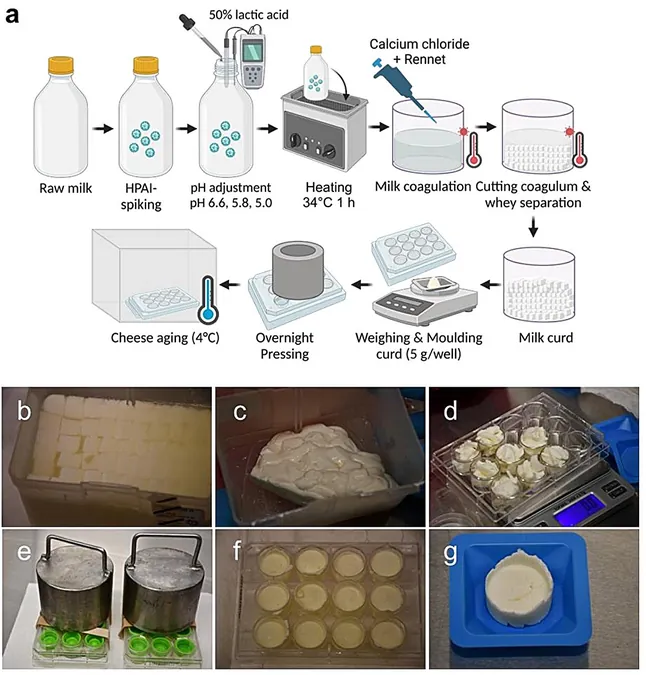
Groundbreaking Research Reveals Heat Sensitivity of Avian Flu in Raw Milk - What Dairy Consumers Need to Know!
2025-04-07
Author: Emily
In a startling development from March 2024, researchers at Cornell University were prompted into action when Texas reported its first cases of highly pathogenic avian influenza (HPAI) in dairy cows. Led by Diego Diel, an associate professor of virology, the team aimed to investigate the survival and susceptibility of the H5N1 virus in raw milk sourced from infected animals.
Nicole Martin, the assistant research professor and director of the Milk Quality Improvement Program at the College of Agriculture and Life Sciences, received numerous inquiries from concerned dairy industry players eager to understand the implications for food safety. Recognizing the urgency of the situation, Diel and Martin collaborated to provide critical insights.
The initial findings from their investigation, published in the prestigious journal Nature Communications, revealed alarming results: the avian flu virus could persist in raw milk for up to eight weeks when stored at refrigerator temperatures. However, the real news came when researchers examined the effects of pasteurization and other heat treatments on the virus. Their studies indicated that pasteurization processes—consistent with FDA recommendations—completely inactivate the virus, ensuring safety for consumers who choose pasteurized products.
Lead researcher Mohammed Nooruzzaman highlighted, “If you consume pasteurized milk, even if it inadvertently comes from a contaminated source, you are protected." Experiments demonstrated that heating the milk to 63 degrees Celsius (145 degrees Fahrenheit) for 30 minutes or to 72 degrees Celsius (162 degrees Fahrenheit) for just 15 seconds effectively eliminated the virus.
Notably, the researchers discovered that temperatures below those typically used in pasteurization could also deactivate the virus. Their data indicated that the H5N1 virus was rendered inactive at 60 degrees Celsius (140 degrees Fahrenheit), and even at 54 degrees Celsius (129 degrees Fahrenheit) for ten minutes, the potential risk could be eliminated.
Given these revelations, Nooruzzaman advised, “For safety, it is wise to avoid drinking raw milk. However, heating it to just 54 degrees Celsius for a brief period of time will ensure the virus is completely inactivated.” Were consumers unsure of their dairy’s safety, upping the heat to 60 degrees Celsius for a mere five seconds would add an extra layer of assurance.
This research is particularly vital for artisan cheese makers who often utilize raw milk in their production. Diel’s research further demonstrated that the avian flu virus could linger in raw milk cheeses for up to 60 days—a misconception that aging would eliminate the virus. However, he reassured that the identified subpasteurization temperatures are effective at killing off the virus, thus offering a practical solution for cheese artisans wishing to keep their customers safe.
While prior studies raised doubts over the efficacy of pasteurization in neutralizing HPAI H5N1, they faltered under questionable temperature measurement methods. The Cornell research team verified their findings using advanced technology that accurately assessed milk temperature, aligning their results with earlier FDA and USDA studies featuring commercial pasteurizers.
Looking ahead, Cornell researchers plan to continue their explorations into the behavior of avian flu in milk as new strains emerge and the dairy industry seeks clarifications. Monthly virtual office hours held by the Cornell Institute for Food Safety have proven invaluable for industry stakeholders, providing direct insights and answered queries from researchers.
Martin expressed the importance of accessible scientific guidance, stating, “It’s essential for the industry to recognize that we are a resource they can turn to. This research is not about diminishing the industry but about illustrating best practices and paving the way for safer dairy production.”
Take heed, consumers! Your choice between raw and pasteurized milk just got a whole lot clearer—stay informed and stay safe!









 Brasil (PT)
Brasil (PT)
 Canada (EN)
Canada (EN)
 Chile (ES)
Chile (ES)
 Česko (CS)
Česko (CS)
 대한민국 (KO)
대한민국 (KO)
 España (ES)
España (ES)
 France (FR)
France (FR)
 Hong Kong (EN)
Hong Kong (EN)
 Italia (IT)
Italia (IT)
 日本 (JA)
日本 (JA)
 Magyarország (HU)
Magyarország (HU)
 Norge (NO)
Norge (NO)
 Polska (PL)
Polska (PL)
 Schweiz (DE)
Schweiz (DE)
 Singapore (EN)
Singapore (EN)
 Sverige (SV)
Sverige (SV)
 Suomi (FI)
Suomi (FI)
 Türkiye (TR)
Türkiye (TR)
 الإمارات العربية المتحدة (AR)
الإمارات العربية المتحدة (AR)